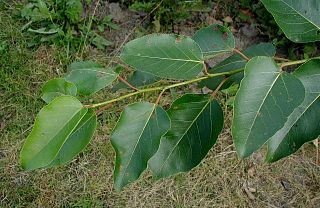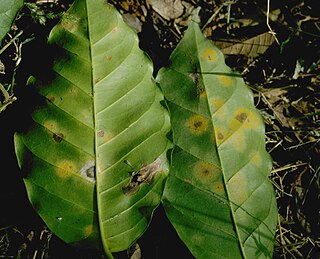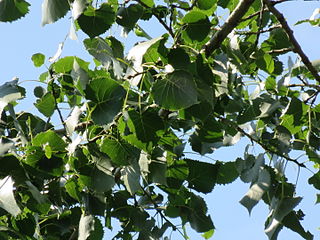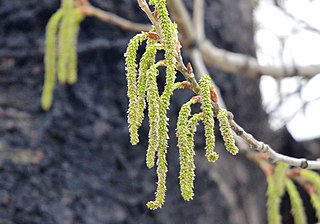
Rusts are fungal plant pathogens of the order Pucciniales causing plant fungal diseases.

Populus is a genus of 25–30 species of deciduous flowering plants in the family Salicaceae, native to most of the Northern Hemisphere. English names variously applied to different species include poplar, aspen, and cottonwood.

Populus section Aigeiros is a section of three species in the genus Populus, the poplars. Like some other species in the genus Populus, they are commonly known as cottonwoods. The species are native to North America, Europe, and western Asia. In the past, as many as six species were recognized, but recent trends have been to accept just three species, treating the others as subspecies of P. deltoides.

The balsam poplars are a group of about 10 species of poplars, indigenous to North America and eastern Asia, distinguished by the balsam scent of their buds, the whitish undersides of their leaves, and the leaf petiole being round in cross-section. They are large deciduous trees, 30–60 m tall, with leaves with a rounded base, pointed apex, and a whitish waxy coating on the underside of the leaf; this latter distinguishes them from most other poplars. The name is derived from the pleasant balsam smell of the opening buds and leaves in spring, produced by a sticky gum on the buds which also helps protect the buds from insect damage. The balsam poplars are light-demanding trees that require considerable moisture. Balsam poplars are tolerant of very cold conditions, occurring further north than other poplars except for the aspens. The poplars in Southern California are tolerant of 100 plus degree heat. They grow along dry washes and dry riverbed's. The dry washes and dry riverbeds will have flowing water when it rains sufficiently. Their leaves hang down and are at an edge to the sun. This may be another factor why they can take the high heat. Their leaves tremble in the slightest breeze like the quaking aspen

Hemileia vastatrix is a multicellular basidiomycete fungus of the order Pucciniales that causes coffee leaf rust (CLR), a disease affecting the coffee plant. Coffee serves as the obligate host of coffee rust, that is, the rust must have access to and come into physical contact with coffee in order to survive.

Populus deltoides, the eastern cottonwood or necklace poplar, is a species of cottonwood poplar native to North America, growing throughout the eastern, central, and southwestern United States as well as the southern Canadian prairies, the southernmost part of eastern Canada, and northeastern Mexico.

Phomopsis cane and leaf spot occurs wherever grapes are grown. Phomopsis cane and leaf spot is more severe in grape-growing regions characterized by a humid temperate climate through the growing season. Crop losses up to 30% have been reported to be caused by Phomopsis cane and leaf spot.

Hyaloperonospora brassicae, in the family Peronosporaceae, is a plant pathogen. It causes downy mildew of species of Brassica, Raphanus, Sinapis and probably other genera within the Brassicaceae. In the past, the cause of downy mildew in any plant in the family Brassicaceae was considered to be a single species Peronospora parasitica. However, this has recently been shown to be a complex of species with narrower host ranges, now classified in the genus Hyaloperonospora, for example Hyaloperonospora parasitica on the weed Capsella bursa-pastoris. From the perspective of plant pathology, Hyaloperonospora brassicae is now the name of the most important pathogen in this complex, attacking the major agricultural and horticultural Brassica species. Other significant Brassicaceous hosts are attacked by different species in the complex, e.g. horseradish by Hyaloperonospora cochleariae, wallflower by Hyaloperonospora cheiranthi.

Populus tremula is a species of poplar native to cool temperate regions of the Old World.

Silver leaf is a fungal disease of trees caused by the fungal plant pathogen Chondrostereum purpureum. It attacks most species of the rose family Rosaceae, particularly the genus Prunus. The disease is progressive and often fatal. The common name is taken from the progressive silvering of leaves on affected branches. It is spread by airborne spores landing on freshly exposed sapwood. For this reason cherries and plums are pruned in summer, when spores are least likely to be present and when disease is visible. Silver Leaf can also happen on poming fruits like apples and pears. Plums are especially vulnerable.

Gymnosporangium juniperi-virginianae is a plant pathogen that causes cedar-apple rust. In virtually any location where apples or crabapples (Malus) and eastern red cedar coexist, cedar apple rust can be a destructive or disfiguring disease on both the apples and cedars. Apples, crabapples, and eastern red cedar are the most common hosts for this disease. Similar diseases can be found on quince and hawthorn and many species of juniper can substitute for the eastern red cedars.

Puccinia asparagi is the causative agent of asparagus rust. It is an autoecious fungus, meaning that all stages of its life cycle – pycniospores, aeciospores, and teliospores – all develop upon the same host plant . Rust diseases are among the most destructive plant diseases, known to cause famine following destruction of grains, vegetables, and legumes. Asparagus rust occurs wherever the plant is grown and attacks asparagus plants during and after the cutting season. Asparagus spears are usually harvested before extensive rust symptoms appear. Symptoms are first noticeable on the growing shoots in early summer as light green, oval lesions, followed by tan blister spots and black, protruding blisters later in the season. The lesions are symptoms of Puccinia asparagi during early spring, mid-summer and later summer to fall, respectively. Severe rust infections stunt or kill young asparagus shoots, causing foliage to fall prematurely, and reduce the ability of the plant to store food reserves. The Puccinia asparagi fungus accomplishes this by rust lowering the amounts of root storage metabolites. The infected plant has reduced plant vigor and yield, often leading to death in severe cases. Most rust diseases have several stages, some of which may occur on different hosts; however, in asparagus rust all the life stages occur on asparagus. Because of this, many observers mistake the different stages of the Puccinia asparagi life cycle as the presence of different diseases. The effects of Puccinia asparagi are present worldwide wherever asparagus is being grown. Asparagus rust is a serious threat to the asparagus industry.

Puccinia coronata is a plant pathogen and causal agent of oat and barley crown rust. The pathogen occurs worldwide, infecting both wild and cultivated oats. Crown rust poses a threat to barley production, because the first infections in barley occur early in the season from local inoculum. Crown rusts have evolved many different physiological races within different species in response to host resistance. Each pathogenic race can attack a specific line of plants within the species typical host. For example, there are over 290 races of P. coronata. Crops with resistant phenotypes are often released, but within a few years virulent races have arisen and P. coronata can infect them.

Comandra is a monotypic genus containing the single species Comandra umbellata. Its common names include bastard toadflax, umbellate bastard toadflax, and common comandra. The plant has a disjunct distribution; its four subspecies occur in North America and the Mediterranean.

Aspen is a common name for certain tree species; some, but not all, are classified by botanists in the section Populus, of the Populus genus.
Septoria musiva, correct taxonomic name: Sphaerulina musiva, is an ascomycete fungus responsible of a leaf spot and canker disease on poplar trees. It is native on the eastern cottonwood poplar Populus deltoides, causing only a leaf spot symptom. On susceptible hybrid poplars, S. musiva causes necrotic lesions on the leaves which lead to premature defoliation, and cankers on the stem and branches which can reduce growth, predispose the tree to colonisation by secondary organisms, and cause stem breakage.
Aspen trunk rot is a fungal disease that causes stem decay heart rot of living aspen trees. The pathogen that causes this disease is the fungus Phellinus tremulae. Most of the symptoms of this disease are internal, with the only external signs of a diseased aspen being fruiting bodies called conks. A single conk found on an aspen can indicate advanced decay of up 82% of the tree volume. Internal decayed wood of freshly cut aspens is spongy, yellow/white colored, surrounded by black zones of discoloration, and contains a distinct wintergreen smell. The fungus is spread via airborne spores released from the fruiting body which can infect through dead branches, branch stubs, or wounds in the tree. Although no direct management control is known, harvesting aspen stands that have been damaged or harvesting stands before decay becomes advanced minimizes tree loss. Aspen wood is white, malleable but strong, and heat-tolerant and therefore has many commercial uses including matches, packing paper, lumber, plywood, pulp, and animal beds. Aspen trees diseased with aspen trunk rot decrease the economic value of the lumber.
Melampsora amygdalinae is a fungal pathogen and part of the division Basidiomycota. It is known as a rust fungus that is host specific. M. amygdalinae commonly infects willows of the genus Salix. This fungus was first discovered in 1909 by Heinrich Klebahn who was a professor of soil biology in Hamburg. Neimi at el. explain how the pathogen occurs throughout the whole distribution of the host, and the small natural populations are an area of interest. This rust fungus is annual and autoecious, which references the fungus spending its entire life in a single host.

Puccinia sorghi, or common rust of maize, is a species of rust fungus that infects corn and species from the plant genus Oxalis.

Populus × tomentosa, commonly known as Chinese white poplar or Peking poplar, is a species of tree in the family Salicaceae. It is found across northern and eastern China, and has been introduced to the US state of Louisiana.

















